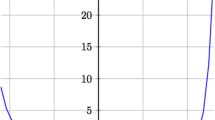Abstract
We use a Monte Carlo experiment to compare the quadratic and translog functional forms in terms of their ability to approximate known frontiers that possess convex curvature. Unlike some of the existing simulation studies that have considered concave frontiers, we find that both functional forms provide a reliable approximation when a true frontier is convex. Our results lend support to existing intuitive explanations concerning the translog form’s innate propensity to yield convex, rather than concave, frontier estimates, suggesting that it should fare relatively well when modeling input isoquants. We also demonstrate that the quadratic functional form loses less of its flexibility than the translog function when shape constraints are imposed to satisfy regularity.



Similar content being viewed by others
Notes
See Wolff (2015) for a recent discussion of techniques for imposing monotonicity and curvature on parametric functional forms.
We cite these “reference” papers repeatedly throughout the text, due to their importance in motivating the present study.
Here we have chosen g = (1, 1).
In addition to these two benchmarks, Färe et al. (2010) and Chambers et al. (2013) also compute the Euclidean distance between the true and estimated frontier points. They subsequently average across these three discrepancies before assessing the results using a single criterion, which is based on that average. Here we use only two benchmarks and choose to compare the translog and quadratic functions’ ability to approximate the true MRTS separately from elasticity.
We report the median rather than the average benchmark values to deal with very large estimates of MRTS that can distort the benchmark for some replications when an isoquant has a nearly horizontal slope at certain points or over certain regions of data.
Färe et al. (2010) report that “… in the case of the true polynomial technologies, the quadratic function’s global behavior is clearly superior to that of the translog function,” and Chambers et al. (2013) mention that “… the quadratic parameterizations are overall better than translog in approximating both types of true technologies….”.
References
Aigner D, Chu SF (1968) On estimating the industry production function. Am Econ Rev 58:826–839
Aigner D, Lovell CAK, Schmidt P (1977) Formulation and estimation of stochastic frontier production function models. J Econom 6:21–37
Barnett WA (2002) Tastes and technology: curvature is not sufficient for regularity. J Econom 108:199–202
Chambers RG, Chung Y, Färe R (1996) Benefit and distance functions. J Econ Theory 70:407–419
Chambers RG, Chung Y, Färe R (1998) Profit, distance functions and Nerlovian efficiency. J Optim Theory Appl 98:351–364
Chambers RG, Färe R, Grosskopf S, Vardanyan M (2013) Generalized quadratic revenue functions. J Econom 173:11–21
Denny MC (1974) The relationship between functional forms for the production system. Can J Econ 7:21–31
Diewert E (1976) Exact and superlative index numbers. J Econom 4:115–145
Färe R, Lundberg A (2006) Parameterizing the shortage function. Mimeo
Färe R, Primont D (1995) Multi-output production and duality: theory and applications. Kluwer Academic Publishers, Boston
Färe R, Sung KJ (1986) On second-order Taylor’s series approximation and linear homogeneity. Aequ Math 30:180–186
Färe R, Martins-Filho C, Vardanyan M (2010) On functional form representation of multi-output production technologies. J Prod Anal 33:81–96
Guilkey DK, Knox Lovell CA, Sickles RC (1983) A comparison of the performance of three flexible functional forms. Int Econ Rev 24:591–616
Luenberger DG (1992) Benefit functions and duality. J Math Econ 21:461–481
Morishima M (1967) A few suggestions on the theory of elasticity. Kenzai Hyoron (Econ Rev) 16:144–150
Ryan DL, Wales TJ (2000) Imposing local concavity in the translog and generalized Leontief cost functions. Econ Lett 67:253–260
Shephard RW (1953) Cost and production functions. Princeton University Press, Princeton
Shephard RW (1970) Theory of cost and production functions. Princeton University Press, Princeton
Terrell D (1996) Incorporating monotonicity and concavity conditions in flexible functional forms. J Appl Econom 11:179–194
Wales TJ (1977) On the flexibility of flexible functional forms. J Econom 5:183–193
Wolff H (2015) Imposing and testing for shape restrictions in flexible parametric models. Econom Rev. doi:10.1080/07474938.2014.975637
Acknowledgments
The authors would like to thank the two anonymous referees and the participants of the 13th European Workshop on Efficiency and Productivity Analysis for many helpful suggestions regarding the manuscript’s earlier drafts. Any remaining errors are our responsibility.
Author information
Authors and Affiliations
Corresponding author
Rights and permissions
About this article
Cite this article
Färe, R., Vardanyan, M. A note on parameterizing input distance functions: does the choice of a functional form matter?. J Prod Anal 45, 121–130 (2016). https://doi.org/10.1007/s11123-015-0448-9
Published:
Issue Date:
DOI: https://doi.org/10.1007/s11123-015-0448-9




